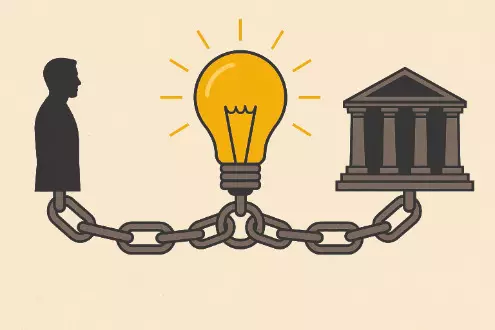Individuals. Ideas. Institutions.
As institutions age and societies rush ahead, the challenge is keeping alive the dialogue between visionaries, the ideas they spark and the systems meant to carry them forward

A few weeks ago, over an unhurried cup of coffee in my hometown, a friend pointed to a dilapidated bungalow across the street. “That place,” he said, “was once the headquarters of a cooperative that transformed this entire district. Started by one man with a stubborn idea—and look at it now, swallowed by a mall.” He wasn’t saying it with nostalgia as much as with a quiet warning. “That’s the thing about nations,” he added. “They rise when individuals carry ideas, and they decline when institutions forget them.” His remark lingered with me long after the conversation ended, because in one stroke he had captured what I’ve long believed: that human progress can be understood through a simple but profound chain—individuals, ideas, and institutions. And that the moment any link weakens, the entire chain begins to fray.
Every institution we admire today, and many we take for granted, began with the courage of an individual who refused to accept the world as it was handed to them. Sometimes this person is a reformer who pushes against tradition; sometimes an entrepreneur who dreams past today’s constraints; sometimes a thinker who asks the uncomfortable question. These individuals are the sparks. They ignite imagination, they disturb complacency, they widen the horizon of what seems possible. Yet sparks alone cannot illuminate a path for an entire society. For imagination to spread beyond personal conviction, it must be carried by something more durable—an idea.
Ideas are the bridges between one person’s vision and collective purpose. They translate emotion into meaning and conviction into direction. Some ideas arrive with a roar, others with a murmur; some succeed by challenging the world, others by helping people make sense of it. Many fade with time, but a rare few outlive their creators and go on to inspire people who never knew—or even heard of—the original thinker. But even the strongest idea is vulnerable to the erosion of time, unless it finds a structure that can give it continuity. That sturdiness comes from institutions.
Institutions are often spoken of in dry, bureaucratic terms, but at their essence, they are the quiet skeletons that keep societies upright. They convert fluid principles into predictable action and give longevity to what would otherwise remain temporary bursts of brilliance. The best institutions retain the moral clarity of the ideas they were built to protect while adapting to new realities. The worst forget their purpose, becoming monuments instead of movements. More troublingly, when institutions lose memory of the ideas that birthed them, or when they calcify into rigid systems suspicious of change, they cease to nurture new individuals. They then become places where imagination goes not to flourish, but to tire itself out.
We often imagine individuals, ideas, and institutions as a neat, chronological sequence—first the person, then the philosophy, then the organisation. But the truth is far more dynamic. Institutions shape individuals every day: teachers who influence students, bureaucracies that mould young officers, companies that cultivate new entrepreneurs. Ideas evolve within institutions as reformers push for change or reinterpret old principles for new generations. And individuals, at every stage, challenge institutions to rediscover their founding impulses. The relationship is less like a ladder and more like a conversation—one that must continue if a society is to remain alive to its purpose. When individuals stop believing, or ideas stop inspiring, or institutions stop listening, decay doesn’t arrive with a crash; it arrives silently, in drift and disillusionment.
This dialogue between individuals, ideas and institutions feels especially fragile in our present moment. We live in a time of technological acceleration, social churn, political contestation and institutional fatigue. Many of our systems were built for slower, more predictable eras and now struggle to keep pace with demands that shift every few months. At the same time, individuals brimming with imagination often feel stifled by structures that move too cautiously, while institutions worry that rapid change may erode the stability they were designed to protect.
The key question for our age is how to keep the dialogue going: how to ensure individuals find the space to think boldly, how to keep ideas flexible and relevant, and how to make institutions both reliable and responsive.
It is in moments like these that the lives of past leaders acquire renewed relevance—not as icons to be idolised, but as examples of how this delicate chain can be held together. Lal Bahadur Shastri is one such figure whose legacy quietly illuminates this dynamic. His leadership was marked not by spectacle but by moral steadiness, not by grand declarations but by clear-headed institution building. He believed that ideas achieve meaning only when translated into structures that serve ordinary people, and that institutions remain strong only when rooted in simplicity, integrity and trust.
His example reminds us that strength need not be loud and that endurance often comes from clarity rather than force. It is a reminder—not nostalgia—of how the chain between individuals, ideas and institutions is neither theoretical nor abstract, but profoundly real.
As we navigate our own moment of transition, perhaps the lesson to carry forward is both simple and demanding. Societies thrive when individuals dare to imagine differently, when ideas inspire more than they divide, and when institutions hold firm without shutting their doors to renewal. None of these pillars can sustain itself alone. The spark needs the bridge; the bridge needs the anchor; the anchor must stay connected to the spark.
If each generation can strengthen this chain in its own way, then the past remains alive, the present becomes purposeful, and the future stays within reach.
Views expressed are personal. The writer is the President of Chintan Research Foundation



